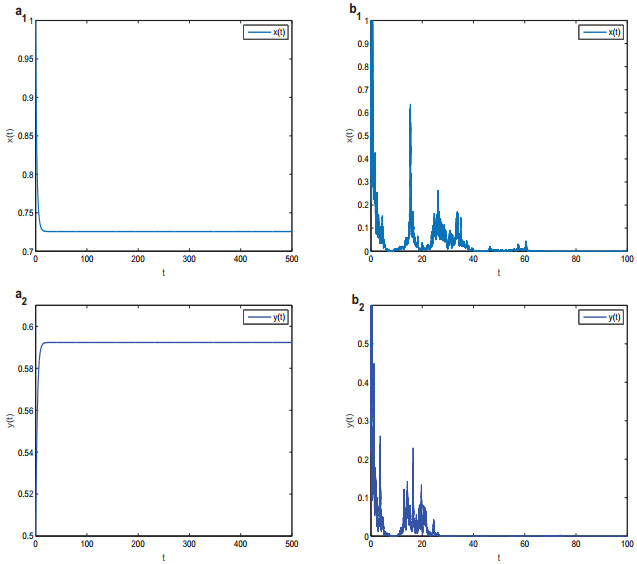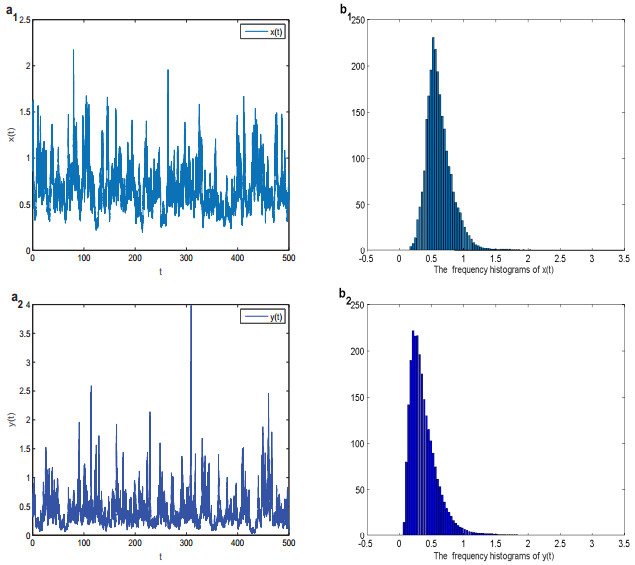1.
Introduction
In the last few decades, the mathematical models, which describe the effect of competition caused by limited resources on the growth of species, have been established and explored extensively [1,2,3,4,5]. On the other hand, time delay accompanies the whole process of species population survival and reproduction. Because of the variety of delay between different individuals of the same species or the cumulative effect of the past history of a system, it is more appropriate to establish model with distributed delay [6,7,8]. Cushing [9] and MacDonald [10] introduced the weak kernel and the strong kernel functions to describe the distributed delay, later on, these two kinds of kernels have been investigated by many scholars (see [11,12,13,14]).
With the idea of the weak kernel functions, we formulate the following competitive system with distributed delays
where x and y measure the population densities of two competing species. αie−αit(αi>0) are the weak kernel functions. The delays are the time passing between the intra-specific competition at a given instant and its effect, at a later time, on the dynamics of the two species. The coefficients ri, bi, ci (i=1,2) are positive constants, and represent the intrinsic growth rates, the intra-specific competitive rates and the inter-specific competitive rates, respectively. The term c1y/(1+y) (or c2x/(1+x)) is an increasing function with respect to y (or x) and has a saturation value for large enough y (or x).
There are many related ecology and investigations of system (1.1). Especially, for system (1.1) without delays, Wang and Liu [15] analyzed the existence and global stability of almost periodic solutions of system, Li et al. [16] investigated the stability and Turing pattern of system with self- and cross-diffusion effect, Hu and Liu [17] took two coupling noise sources into account and obtained the sufficient conditions for survival results of system. On the other hand, for system (1.1) with discrete delays, Chen and Ho [18] discussed the persistence and global stability of system, Liu et al.[19] studied the existence of positive periodic solutions of system with impulsive perturbations. Obviously, it can be seen from the above literatures that they did not consider system with distributed delays. To reveal the effect of distributed delays we propose system (1.1).
Denote
By applying the linear chain technique, system (1.1) transforms into the following equivalent four-dimensional system
Due to environmental noise, the birth rate and other parameters involved in a system can reflect random fluctuation to some extent[20,21,22]. Some researches indicate that random interference cannot be ignored for competitive ecological models [23,24,25]. In addition, many researchers also introduced higher order perturbations into the system when the random perturbations may depend on the population's density[26,27]. Therefore, in this paper, similarly to [17,28] we further incorporate two noise sources in the system (1.3), that is, one noise source not only has influence on the intrinsic growth rate of one species but also on that of the other species. Strongly inspired by the above arguments, we assume that the white noises affect ri(i=1,2) mainly according to
and obtain the following stochastic system which corresponds to the deterministic system (1.3)
Here, for convenience' sake, let x=x(t), y=y(t), u=u(t), v=v(t), and dBi=dBi(t)(i=1,2). Bi are the independent standard Brownian motions defined on the complete probability space (Ω,F,P) with a filtration {F}t≥0 satisfying the usual conditions, that is Bi are normally distributed with mean 0 and variance t (see [29]), and σ2ij(i,j=1,2) denote the intensities of the white noises.
The rest of this paper is arranged as follows. Section 2 focuses on exploring the unique global positive solution to system (1.5). Sufficient conditions for extinction of the species and the existence of a stationary distribution of the positive solutions to system (1.5) are obtained in section 3 and section 4, respectively. In section 5, several examples are demonstrated to verify our results and a brief discussion is given.
2.
Global positive solution
Assign
Theorem 2.1. For any given initial value (x(0),y(0),u(0),v(0))∈R4+, system (1.5) has a unique global positive solution for any t≥0.
Proof. Obviously, for any initial value (x(0),y(0),u(0),v(0))∈R4+, there is a unique local solution (x(t),y(t),u(t),v(t))∈R4+ on t∈[0,τϱ), where τϱ denotes the explosion time. To complete the proof, we only need to show that τϱ=+∞ a.s. Similarly to [29], we construct a nonnegative C2–function V:R4+→R+ satisfying
where On=(1n,n)×(1n,n)×(1n,n)×(1n,n) and n>1 is a sufficiently large integer and K is a positive constant. Let 0<p<1, we assign
Since −lnz→+∞ as z→0, and zpp−lnz→+∞ as z→+∞, where p>0, we can obtain that lim infn→+∞,(x,y,u,v)∈R4+∖OnV(x,y,u,v)=+∞. In the following, we will verify that LV(x,y,u,v)≤K. An application of Itô's formula shows that
where
The rest proof is similar to Theorem 2.1 in [30] and hence we omit it here.
3.
Extinction
Theorem 3.1. If r1<12(σ211+σ212), r2<12(σ221+σ222), then both x(t) and y(t) will be extinct exponentially.
Proof. Using Itô's formula in the first equation of system (1.5), one can show that
Integrating from 0 to t and dividing by t on both sides of the above equality lead to
Denote Zi(t)=σ1i∫t0x(s)dBi(s), so that its quadratic variation is
Using the exponential martingale inequality and the Borel-Cantell lemma, similar to [27,31], we have that for almost all ω∈Ω, there is a random integer l0=l0(ω) such that for l≥l0,
For all 0≤l−1≤t≤l, l≥l0, substituting (3.3) to (3.2), we have
The strong law of local martingales implies that
Taking the superior limit on both sides we get
Similarly, one can obtain that
The proof is completed.
4.
Existence of stationary distribution
Consider the integral equation
where σr(s,X(s)) and Bξ(s) are vectors.
Lemma 4.1. [32] Suppose that the coefficients of (4.1) are independent of t and satisfy the following conditions for some constant N
in OR⊂Rd+ for every R>0 and there exists a nonnegative C2−function W(x) in Rd+ such that LW(x)≤−1 outside some compact set. Then the system (4.1) exists a solution which is a stationary distribution.
Remark 4.1. The condition (4.2) in Lemma 4.1 can be replaced by the global existence of the solution of (4.1) in view of Remark 5 in Xu [33].
Assign
Theorem 4.1. If βi>0(i=1,2), then there exists a positive solution (x(t),y(t),u(t),v(t)) of the system (1.5) which is a stationary Markov process.
Proof. Since we have obtained the existence of the global positive solution of system (1.5) in Theorem 2.1, from Remark 4.1, we only need to consider a nonnegative C2−function W(x,y,u,v) and a closed set O⊂R4+ satisfying
One derives from system (1.5), by Itô's formula, that
and for the constant 0<p<1, we have
Define
where Mi=2βimax{2,Ji}, Ji (i=1,2) are positive constants which will be determined later. Since ˜W(x,y,u,v) is a continuous function, there exists a minimum point (ˆx,ˆy,ˆu,ˆv) in the interior of R4+. Then we can choose the following C2–function W:R4+→R+∪{0}
which, together with (4.4)–(4.5), leads to
Let ϵ>0 be sufficiently small such that
Define the bounded closed set
Assign
Case 1. When (x,y,u,v)∈Oϵ1, it follows from (4.8) that
where
Since M1=2β1max{2,J1}, one can see that M1β14≥1. Then we have from (4.9) that
Similarly, for any (x,y,u,v)∈Oϵ3,
where
Since M2=2β2max{2,J2}, we have M2β24≥1. It follows from (4.9) that
Recalling (4.8), we can calculate that
where
Case 2. When (x,y,u,v)∈Oϵ2, by (4.9) we can derive that
Similar, if (x,y,u,v)∈Oϵ4, then we have
Case 3. When (x,y,u,v)∈Oϵ5 or (x,y,u,v)∈Oϵ7, we have from (4.9) that
Case 4. When (x,y,u,v)∈Oϵ6 or (x,y,u,v)∈Oϵ8, it follows from (4.9) that
The above analysis shows that there is a closed set Oϵ defined by (4.10) such that
The proof is completed.
5.
Numerical simulations and discussions
To illustrate our theoretical results, we will perform several specific numerical simulations. We first fix r1=0.4, r2=0.6, b1=0.5, b2=0.8, c1=0.1, c2=0.3, α1=0.1, α2=0.2. Let σ11=σ12=σ21=σ22≡0, and we find that both of two species are persistent (see Figure 1(a1)–(a2)). However, if σ11=0.9, σ12=0.5, σ21=1, σ22=0.8, then we have from Theorem 3.1 that x(t) and y(t) will be extinct exponentially (see Figure 1(b1)–(b2)). When we choose σ11=0.1, σ12=0.15, σ21=0.3, σ22=0.25, it follows from Theorem 4.1 that the system (1.5) has a stationary distribution (see Figure 2).
Our theoretical results and the above numerical examples reveal that the coupling noises can change the asymptotic properties of system (1.5).
(Ⅰ) For ecosystems, it is important to analyze the survival of species. It can be seen from Figure 1(a1)–(a2) that the two competing species can survive if the competitive system is not affected by environmental noise. However, two species will go to extinction if the coupling noises are suitable large (see Figrue 1(b1)–(b2)).
(Ⅱ) To analyze the statistic characteristic of the long-term behaviors of the sample trajectories, a useful approach is to study the stationary distribution. Figure 2 implies that the relatively small coupling noises can ensure the existence of a stationary distribution.
Acknowledgments
The authors thank the editor and referees for their careful reading and valuable comments. The work is supported by the National Natural Science Foundation of China (Nos.11871201, 11961023), and Natural Science Foundation of Hubei Province, China (No.2019CFB241).
Conflict of interest
The authors declare there is no conflict of interest.










 DownLoad:
DownLoad:




